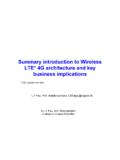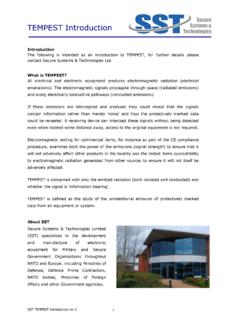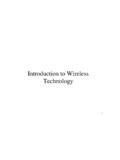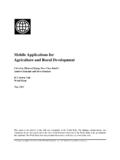Transcription of Introducing Mobile Technology - Future Classrooms
1 : introduction 1 Introducing Mobile TechnologyA handbook for all schools in Northern Ireland Future Classrooms introduction Context The Creative Learning Centres Creativity and digital literacy Why Mobile ? Desktop vs. Mobile PLAN - What needs to be considered before I introduce Mobile Technology to my school? Know your starting point Establish a strong vision and clear ICT strategy Evaluate current ICT support and form a project team Design an ICT infrastructure development plan Decide a rollout model Choose Mobile devices Calculate the costs Develop a project plan and timeline Revisit current e-Safety policies and update for Mobile devices PREPARE & SUPPORT What are the first steps in preparing my school for Mobile learning? Setup devices with initial settings and agreed restrictions Begin with teachers Develop support documentation and resources Prepare a communication strategy DEPLOY How do I implement Mobile Classrooms ?
2 What is a Mobile classroom? Plan and timetable pupil access to shared sets of devices Provide pupil induction MONITOR & EVALUATE How do I know Mobile learning is making a difference? Baseline pupils and implement monitoring systems Sustain and develop meaningful access to Technology FINAL THOUGHTS CONTACTS & to use this HandbookSchools across Northern Ireland have been contacting the Creative Learning Centres seeking advice, training and solutions on how best to deploy and integrate Mobile devices in their Classrooms . This handbook is designed to provide guidance to school leaders hoping to introduce Mobile devices in primary or post-primary schools and to support them in making informed, well balanced LEARNING CENTRES Written by:Sarah Lawrence, Daniel O Reilly and Maura McKeeWith contributions from:Marian Murray (Bangor Central Primary), Lois Stewart (St Malachy s, Belfast), Lisa Brown (Kilronan School), Mr.
3 P Hart & Mr. P Loughran (St. Josephs, Madden), Mrs T. O Hagan (St. Brendans Primary, Moyraverty), David Cleland (Wallace High School), P. McBride & B. Hyndman (Bangor Academy & Sixth Form College).With thanks to:Ken Armstrong, Meabh McCaffrey-Lau, John Peto, Averil Morrow, Bernard McCloskey, Alastair Crease, Eibhlin Tinneny. Copyright Creative Learning Centres 2013 AmmA Centre MarkethouseMarket StreetArmagh BT61 7BU028 3751 Nerve Centre7-8 Magazine StreetDerry~LondonderryBT48 6HJ028 7126 ON2 School RoadCrossnacreevyBelfastBT5 7UA028 9044 : introduction 54 Future the CLCs provide training for over 2,000 teachers in Northern Ireland each year and work strategically with the education sector, including the ELBs and CCEA, to help our schools enhance learning experiences by integrating creativity and digital Technology into learning in the classroom. In addition, the centres provide opportunities for over 4,000 young people every year across Northern Ireland to engage creatively with digital Technology in a variety of exciting programmes, covering everything from film, animation and music production to programming, games and 3D.
4 Over the last 10 years the CLCs have gained a wealth of experience by working with and supporting a huge range of schools and youth & community groups throughout Northern Ireland. By striving to develop new ideas and strategies, the CLCs also work closely with hardware and software companies to test and evaluate new technologies and their potential for use in education. However, the centres maintain an independent position and only recommend products and services that have the potential to positively impact on teachers and learners. As part of the quality assurance of our training and our overall work we are regularly evaluated and inspected by the AND DIGITAL LITERACyCreativity and digital literacy are fast becoming vital skills for all 21st Century citizens. The Northern Ireland Curriculum identifies Using ICT and Thinking Skills and Personal Capabilities as being a crucial part of our children s education and these skills are valued in all areas of employment.
5 When young people discover their creative abilities it can have an enormous impact on their self-esteem and on overall achievement. Added to this is the fact that the creative industries have been recognised as a huge growth area in our economy and therefore creativity combined with media awareness and technical skills are now more important than ever for the success and employment of the Future learningCreativity is a process that has been described as the capacity in all people to combine skills, knowledge and resources to solve problems in new ways in any context and within any group, (DCAL, 2000)2. Creative learning involves an active, structured approach and relies on the application of acquired knowledge, the mastering of materials and techniques and the organisation of ideas. It is not a separate capacity that some young people have and others learning can take place in all areas of activity including the arts, sciences, work, play and other social environments.
6 It encourages innovation by connecting ideas not previously literacyDigital Literacy is the ability to access, understand and create communications in a variety of contexts using digital Technology . 3: Young people receive their ideas, stories, information and entertainment not only from books and other printed forms of media, but also from television, films, DVDs and increasingly from the internet and Mobile devices. In order to become valued citizens who contribute and participate fully in society and the workplace, our young people need the skills to actively understand, criticise and use these media in creative ways, rather than just passively consuming them. This digital literacy should be a basic entitlement for every child in every school in Northern DCAL Unlocking Creativity: A Strategy for Development, 2000, p 153 NIFTC/BFI Education Policy Working Group, A Wider Literacy: The Case for Moving Image Media Education in Northern Ireland, 2004 Although print literacy is immensely important, it is no longer enough to ensure young people s full participation in the culture, social life and politics of the 21st century.
7 A Wider Literacy (NIFTC/BFI, 2004) On 1st April 2012, the new C2k Education Network contract came into place which will deliver the next generation of education Technology services to all grant-aided schools across Northern Ireland. The new service has been designed to recognise and facilitate the changing nature of Technology , including the use of personal smart Mobile devices and tablet computers, alongside the specific educational requirements of Northern Ireland s schools. 1 INTRODUCTIONCONTExTThe creative use of Technology in our Classrooms has been an exciting development, presenting schools and school leaders with both opportunities and challenges for learning. The pace of change reflects the unprecedented revolution in the use of Technology in wider society and continues to challenge our education system and our policy makers. Purposeful access to ICT across the curriculum that motivates and increases engagement and achievement in education will be essential in preparing our young people for the economy of tomorrow.
8 Mobile devices play an important role, not only for our young people, but also for the wider community and business infrastructure. Research from around the world indicates that under the right conditions, their use can significantly enhance learning new C2k network in Northern Ireland aims to support 1:1 access (one device to one user), offering schools the opportunity to implement an effective Mobile solution for their teachers and young people. However, there are still major questions around which technologies are most effective and how to ensure their use maximises CREATIVE LEARNING CENTRESThe Creative Learning Centres (CLCs) presently operate from the Nerve Centre in Derry~Londonderry, the AmmA Centre in Armagh and Studio ON in Belfast. Funded by DCAL and managed by NI Screen, the CLCs work together to offer an integrated programme of support and training in digital literacy and the creative use of media and Technology for the education and youth/community sectors.
9 The remit of the CLCs is to work with young people, teachers and leaders throughout these sectors. 1 1 C2k Communications Team Feb : introduction 76 Future CLASSROOMSWHy Mobile ? Mobile devices are increasingly growing in popularity in the home and at work. According to recent research, 39% of 2-4 year olds have used a smart device, with this jumping to 52% among 5-8 year olds4, while a CISCO report says the number of smartphones, tablets, laptops and internet-capable phones will exceed the number of humans in by the British Educational Suppliers Association (BESA) concluded that at least 6% of desktop/laptop computers in schools would be tablets by the end of 2012 ( per cent in primary, per cent in secondary), with this rising to 22% by the end of tablet computers and smart phones are offering the opportunity to access a wealth of resources and information that can support pupil led learning and a variety of learning styles.
10 However, it is the access to inbuilt cameras and microphones, as well as an ever-growing list of power apps7 that makes these devices really exciting. Mobile devices are no longer just for consuming media, they allow you to document, edit and create. This means pupils can demonstrate their knowledge and understanding in any area of the curriculum through creative means. 8 Add this to the long battery life, quick boot time, wireless capabilities and portability and you have a device that can also facilitate anytime learning, group work and collaboration both within and outside class and between pupils, teachers and parents. 4 Kid Tech, MDG Advertising. 5 BESA, The Future of Tablets and Apps in Schools (2012). Apps that offer similar capabilities to desktop Clarke, B., Svanaes, S. (2012). One-to-one Tablets in Secondary Schools: An Evaluation Study. Page 25 their books wouldn t empower me to know exactly what their understanding is, whereas them talking about it is a lot better way to assess what their understanding is.




